At Bear Creek Farm, our passion for seeds knows no bounds. Seeds are an invitation to cultivate your very own botanical collection, exploring and discovering varieties beyond the usual selections found at local nurseries. Seeds empower us to experiment and engage with the gardening process in its most fundamental form, offering a canvas for creativity and a deeper connection to the cycle of life. This hands-on approach not only enriches our gardening experience, but also broadens our horizons by introducing us to unique and heirloom varieties that we may not encounter elsewhere.
We are enthusiastic advocates for direct seeding outdoors, though we acknowledge that gardening is a realm without strict guidelines. The magic of planting a single seed directly into the soil, where it will one day flourish into a beautiful flower, is a choice we prefer over beginning in indoor conditions, whenever the weather and other factors allow.
The essence of direct seeding lies in its simplicity: allowing a plant to establish itself in its ultimate environment from the start, supported by the natural rhythms and cycles of the outdoors. This method is particularly favored by native plant seeds, which thrive best when sown directly into their natural habitat, leveraging their innate adaptation to local conditions. Moreover, direct seeding is an approach that requires minimal initial investment and simplifies the growing process, making it more seamless and intuitive.
Despite our fondness for direct seeding, we recognize the eagerness of many gardeners, novices and experts alike, to get their hands in the soil as early as possible. For those facing short growing seasons or cultivating plants with delicate root systems or lengthy germination periods, starting seeds indoors can offer a valuable headstart.
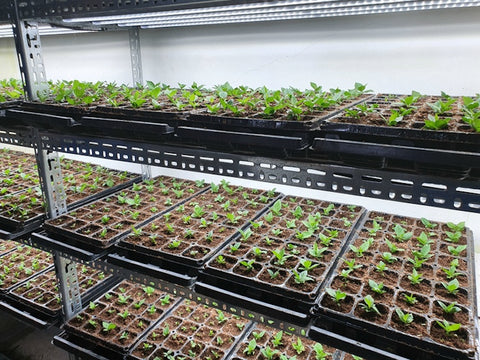
Embarking on Your Seeding Journey
Deciding between direct outdoor seeding and beginning indoors is a choice that can be tailored to your regional climate and personal preferences. Depending on where you live, you can mix it up. Remember, seeds represent a modest financial outlay with the potential for immeasurable returns in beauty and satisfaction.
An Easy Guide to Indoor Seed Starting
Opting for indoor seed starting? We recommend a few key investments to enhance your success rate significantly. These initial purchases may cost more upfront but are designed to increase your seed-to-flower success dramatically:
- Grow lights
- Heat mats
- Shelving units (wooden or metal)
- Cell containers and flat drainage trays
- Plastic covers or dome coverings
- High-quality potting or seed starting mix
Organizing Your Growing Space
Creating an efficient indoor garden starts with some planning. Your space should accommodate the plants' growth needs, including ample room for lighting and other essentials. For an effective setup, we suggest using shelves that can accommodate standard gardening lights, with a preference for metal shelving due to its ease of cleaning and pest resistance.
When selecting soil, opt for a high-quality potting mix to avoid the pests and diseases common in garden soil. Our recommended choice is Pro-Mix with mycorrhizae, which provides the ideal structure for root growth and moisture retention. And when your plants are ready to transition outdoors, consider our specially formulated fertilizer to support their continued growth.
Selecting and Sowing Your Seeds
Choosing your seeds is an exciting step. Consider the specific needs of indoor versus outdoor plants, and perhaps explore some unique varieties that are less commonly found.

Seed Trays vs. Upcycled Containers
There's a charm in repurposing items around the house for seed starting—egg cartons, milk boxes, you name it. Yet, when it comes to getting those seeds off to the best start, purpose-made seed trays have their advantages. They bring a kind of uniformity and efficiency to the process, with features like standardized drainage and spaces designed to help roots thrive. While it's tempting to go with what's on hand, using 72-cell or 50-cell flats can simplify life down the road, making sure those little plants get the room they need without unnecessary transplant stress. (Don't forget to label each tray with the correct species name and sowing date to track progress.)
Prepping for Success
Before those seeds even touch the soil, there's a bit of prep work that can make all the difference. Tamping down moistened soil gently helps avoid air pockets—those tiny voids aren't friends to tender roots. And if you're feeling extra motivated, a sprinkle of vermiculite on top can keep the soil's surface just right, warding off crusts and algae. Covering the seeds with a dome or plastic wrap creates a cozy little microenvironment, perfect for germination.

Embracing the Seedlings' New Phase
When those tiny green shoots break through the soil, it's a sign that the nurturing phase enters a delicate stage. Those little domes or covers you've used to create a cozy, humid environment for germination? They've done their job well, but now it's time to introduce a bit of the outside world to the seedlings. Start by slightly opening or propping up the domes to let in some air, keeping this setup for a day or two. This cautious approach helps the seedlings adjust to a less controlled environment gradually.
Watering Wisdom
As the seedlings grow, their thirst for water and nutrients increases. However, drenching the soil from the top can be less effective and even harmful, compacting the soil and disturbing delicate roots. Instead, adding water to the bottom of a waterproof tray encourages the roots to stretch downward, seeking moisture and, in the process, becoming stronger and more capable of supporting the plant. This method not only hydrates the plants more efficiently but also fosters a robust root system, crucial for their future growth in the garden.
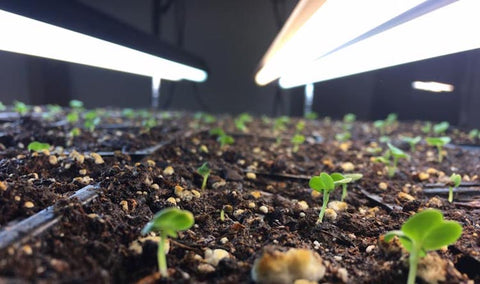
Heat and Light
Keeping seeds warm can be a bit of a Goldilocks situation—not too hot, not too cold. Heat mats are a go-to for consistent warmth, but for a touch of DIY, a sunny windowsill or the top of a fridge might just do the trick. (Though you may outgrow small spaces quickly.) Just keep an eye on the temperature, aiming for that sweet spot around 65-70 degrees Fahrenheit.
And then there's light. Young plants are like solar panels, soaking up those rays to grow strong. If you're using natural light, remember to rotate those trays to keep stems straight and strong. Seeds reach for the sun, resulting in weak stems that bend, which is the reason to keep moving the cell packs to keep stems straight.
Full spectrum lights are fantastic for mimicking the sun's rays if you are going the artificial route, but consistency is key. Keep those lights close, but not too close, and on for about 14 to 16 hours a day to simulate the long days of summer.
The Great Outdoors Awaits
When it's time to introduce your seedlings to the great outdoors, take it slow. This process, known as hardening off, helps plants adjust to the elements gradually. A few hours in a shady spot, increasing time in the sun each day, preps them for life under the sky. Be sure to bring them back in at night. After a week or so, they should be fully acclimated to their new outdoor digs and can be deposited there.
From Seedlings to Full Bloom
This gardening journey is filled with little decisions and adjustments, a process of learning and adapting as you go. It's a conversation with nature, a series of gentle nudges and responses as you and your garden grow together. There's no single right way to do it, just a collection of experiences, insights, and the joy of watching life unfold from the palm of your hand.
For Aspiring Commercial Growers
For those looking to scale up their gardening endeavors, consider making cost-effective decisions, such as the purchase of plugs for larger operations. Assessing the balance between investment, time, and resources is crucial for expanding your gardening venture successfully. The decision between plant care and employee/personal time is a gentle reminder that growth happens in many forms, not just in the soil.


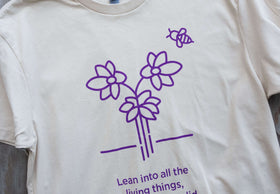
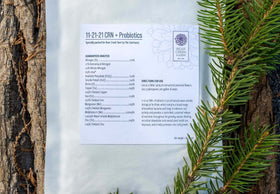
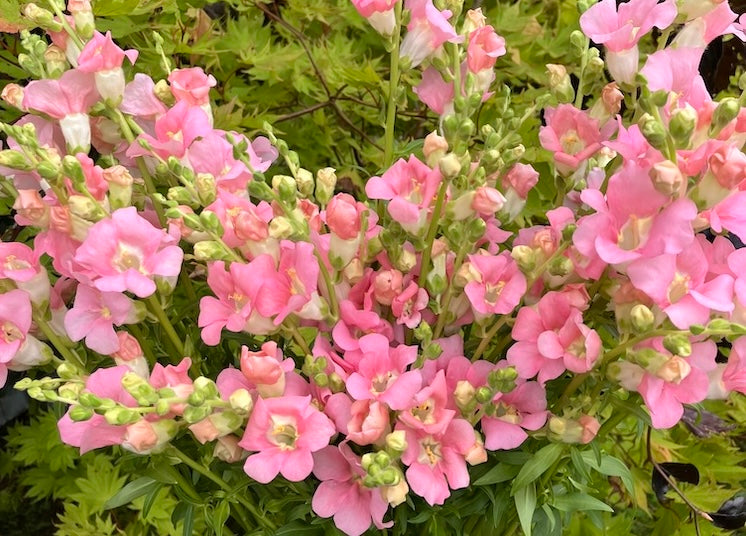
Thank you for this article. I’ve done almost everything right! Saving the article for next year’s perfect process.
Blessings!